|
Throughout history, there have been many who
contributed greatly to the development of firearms. From the
very first successful explosion of gunpowder, through the
refinement of the musket, rifle, and handgun, men have sought
better ways to propel a piece of metal through the air by way of
the firearm.
There are a few great gun designers and
inventors who are legends in firearms history, such as Sam
Colt, Hiram Maxim, Arthur Savage, and the great John
Moses Browning. I also propose that history will find that William
B. Ruger, Sr. will be noted as the greatest of our
time.
Detailing the beginning and rise to prominence
of Sturm, Ruger and Company as the largest manufacturer
of sporting arms in the world is beyond the scope of this
article (Ed. Note: a capsule early history of Sturm, Ruger
can be found at Ruger 50th Anniversary .22
- Boge Quinn). There are books written to cover this in
great detail. This short essay shall concentrate more on the
genius and insight of Bill Ruger as a man who, along with the
company that he founded, has given the shooters of this world
some of the greatest gun designs of our time.
The guns of Bill Ruger are not so much
inventions as they are refinements and improvements of other
designs, combined with improved manufacturing techniques, that
result in a better product. The first firearm produced by Ruger,
the Standard .22 Automatic, has become the worldís
favorite .22 pistol. It is worthwhile to note that when Ruger
introduced this pistol in 1949, there were several fine .22
autos already well-established on the market. Today, those
competitive pistols are long out of production, but the little
Ruger pistol has been sold in the millions, and is the most
popular .22 auto pistol on the market.
The ability of Bill Ruger to read the firearms
market as if through a crystal ball has been demonstrated over
and over again, but there is no better example than that of his
reintroducing the single action revolver to the shooting world
in 1953. The established gun makers of this country had already
placed the nails in the coffin of the single action revolver,
but Ruger was one of the few who saw a market for the beloved
sixgun, and introduced the Single Six revolver to anxious
buyers. He later followed the great success of the Single
Six with the most extensive line of single action revolvers on
the planet, and to this day, supply can hardly meet the demand.
Were it not for the foresight and willingness of Ruger to follow
his instinct with the resurrection of the single action, we most
likely would have not seen the revival of the Colt Single
Action Army, or any of its many copies available today. Rugerís
line of Blackhawk and Vaquero single action
sixguns are some of the strongest and most durable guns of any
kind on the market. They are built strong enough to outlast your
grandchildren, and are, in my opinion, the best handgun value in
United States. A shooter can buy a new, all American-made
Blackhawk today for less than an inferior import copy of the
Single Action Army.
The ability of Ruger to produce superior
products at a lower price is again due to the remarkable
foresight of Bill Ruger in pioneering the use of investment
castings in the manufacturing of firearms. While his competitors
were, and some still are, working with rough forgings and old
machinery, Ruger was producing almost-finished parts from high
quality investment castings. Ruger has proven the strength of
castings throughout the years by using the process in the
manufacture high-stress gun parts such as receivers and bolt
heads.
Another fine example of Ruger going against the
prevailing tide in gun design was the introduction of his first
two center fire rifles. The first was the .44 Carbine, a
fine little autoloader which stayed in production for over 25
years. The second was the single shot Number 1 rifle,
introduced in 1967 and still going strong today. The No. 1 has
become a classic, perhaps the best single shot rifle ever made,
and is currently chambered for 25 different cartridges. Between
the introduction of these two rifles, in 1964, Ruger gave us the
very popular 10/22 auto loading rifle, with the ingenious
little 10 shot rotary magazine. After almost 40 years, the
little carbine is still the standard by which all new .22 auto
loading rifles are compared.
In 1968 Ruger introduced his Model 77
bolt action rifle, which was no great departure from the other
good bolt gun designs of the day, except in the methods used in
the guns production. What set the model 77 apart was the design
of the stock. At a time when most rifle makers were turning out
bolt guns with flashy stocks complete with cheek pieces and
white line spacers, all covered with impressed checkering and a
high gloss finish fit for a pimp on safari, Ruger went with a
classic, straight-combed design with real hand-cut checkering,
again setting the standard for the industry to follow. The Model
77 Mark II is still one of the best rifles on the market,
having been chambered for at least 33 different cartridges, and
is both beautiful and reliable. It is a gun on which you can
depend, and a testament to the genius of the designer.
I remember many years ago, when working
construction at a prison in Eddyville, Kentucky, I saw the wall
guards carrying a handy little .223 auto loading rifle that
turned out to be the Ruger Mini-14. This was my first
glimpse of that fine little carbine, and I knew that I had to
have one. When I finally got my hands on one of my own, I
realized what a great, handy little gun it was. I shot many
thousands of rounds through that Mini, with nary a bobble of any
kind. It would feed, fire, and eject reliably, every time. The
action of the Mini is an improved Garand design, and is
reliable in the extreme.
I will not attempt to cover every gun design
that has risen from the fertile mind of Bill Ruger, as it would
be an undertaking of which I am not qualified, but would like to
mention one more in particular. Before delving into the details
of that last firearm, I would be neglectful to fail to mention
that time and time again, Bill Ruger has ignored those in the
industry that have said that it couldnít be done. From his
first double action revolvers, to the best black powder sixgun
ever made; the Old Army, Bill Ruger has blazed his own
trails through the gun industry, giving the shooting public the
firearms that they wanted at a price that they could afford, and
leaving the competition to try and catch up.
The last gun design that I would like to mention
is that of Rugerís first shotgun; the Red Label. Bill
Ruger introduced the first Red Label in 1977, again bucking
tradition by bringing out the 20 gauge first, when everybody
knew that you had to start with the most popular twelve gauge to
succeed. Instead of building a 12 gauge pump or automatic, Ruger
started with a 20 gauge over-and-under, with a unique design
that is both elegant and bull-strong. Ruger now builds the Red
Label on three different size frames, each to specifically
accommodate either the twelve, twenty, or twenty-eight gauge.
The Red Label is the easiest-opening shotgun on the market,
right out of the box. Again, this is due to the advanced
thinking and design of the shotgun. At a time when other
American shotgun makers canít seem to find an over-and-under
design that will sell, the Red Label has become a classic that
is still going strong. I have one that was built in 1983, and is
still as good as when brand new. Most American gun manufacturers
have conceded the double barrel shotgun market to the Europeans
and Japanese, but not Ruger. The fine folks at Ruger are again
filling a long-empty void in the American shotgun market by
bringing out the long anticipated Gold Label side-by-side
double shotgun. As of this writing, I have yet to fire
one, but I have fondled one extensively, and am very impressed
and anxiously awaiting a production gun for a full review.
Searching through the latest Ruger catalog, I
count 305 different variations of Ruger pistols,
revolvers, rifles, and shotguns. This is a great testament to
the founder of that 53 year old company.
Even with his retirement as the active head of
the corporation, there is no doubt that the team at Sturm, Ruger
and Company are intent upon following the great leadership of
William B. Ruger, the foremost firearms designer of our time.
See
Ruger's entire product line here.
Jeff Quinn
  
Got something to say about this article? Want to agree (or
disagree) with it? Click the following link to go to the GUNBlast Feedback Page.
|
|
Click pictures for a larger version.

William B. Ruger, without a doubt the greatest firearms
designer since John M. Browning.
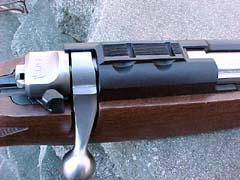
Model 77/22 .22 Rimfire bolt-action rifle.
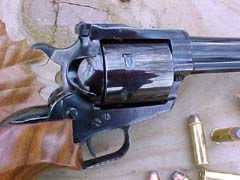
"Old Model" Super Blackhawk .44 Magnum, fitted
with Herrett's "Shooting Star" grips.
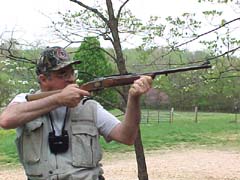
Cousin Butch shooting the No. 1 50th Anniversary
single-shot rifle in .45-70 Government.
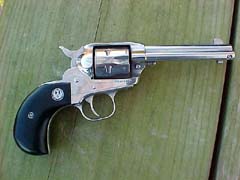
The new .32 Magnum "Bird's Head" Single-Six.

Ruger pioneered the use of rugged and reliable
coil-spring actions in revolvers, making broken mainsprings a
thing of the past.
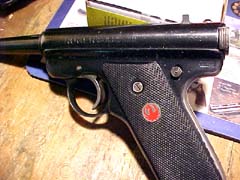
.22 Standard Automatic, serial # 0132.

Model 77 Mark II bolt-action rifle in .338 Winchester
Magnum.
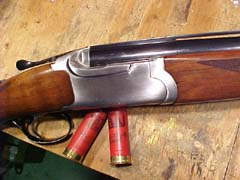
Red Label over/under 12 gauge shotgun.
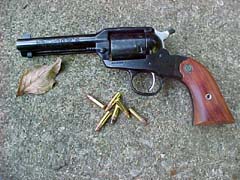
Bearcat small-frame .22 Rimfire singe-action revolver.
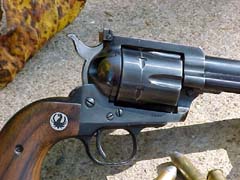
"Old Model" .44 Magnum Blackhawk
"flattop".
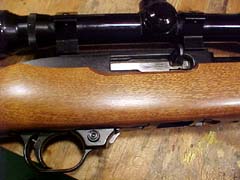
Model 10/22 .22 Rimfire semi-automatic rifle.
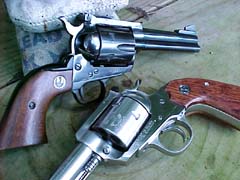
"Old Model" Blackhawk (top) and "New
Model" Stainless Bisley (bottom), both in .45 Colt.
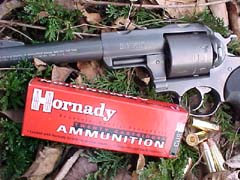
Super Redhawk in .480 Ruger.
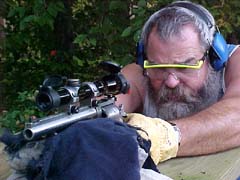
Jeff shoots the .44 Magnum Super Blackhawk Hunter.
|
![]()